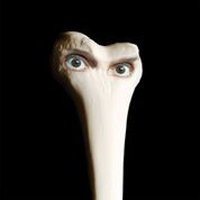
JUANA MOLINA
HALO (Crammed Discs)
My Argentine section is notably sparse and, truth be told, Juana Molina could be from anywhere, Brazil, Spain, Colombia. Her latest album (No 7) is another chapter in her stylish exploration of treated voice over synthesizer and rhythms built from electronic disjecta membra. Wind turns into an electronic wail, and garbage drum sounds from a Roland Sampling drum pad build as live traps, cymbals and guitars (Molina herself via loop) ride along. It's engaging and offbeat enough to keep you wondering where it's going. The closest I can come up with musically is Robert Wyatt. Trying to describe it puts me in mind of a client I once did a printing job for: I had her pick it up from the record store where I worked, Round World Music, which specialized in world music. Do you work here? she asked. Yes, I said. Well, that's nice ... if you like that sort of thing, she replied. Words to live by. So if you like this kind of thing: breathy Spanish pop vocals about "icy feet" over a mysterious sometimes atonal backing track that builds to a peak then evaporates like smoke, then go for it. The "Halo" of the title refers not to sanctity but to the mysterious lights that float above ground at night and scare travelers. In concert the synth player, Odin Schwartz, who likes the pitch bend wheel a bit too much, doubles on bass and guitar and adds backing vocals.

JUANA MOLINA
WED 21 (Crammed Disc 220-P)
The Argentine sorceress is back for Halloween/Day of the Dead with her witchcraft. She takes an experimental approach to music, using ideas that would have done credit to early Steve Reich: simple synth squelches looped, the oddly dissonant metallic sounds that recall Harry Partch's cloud chamber bowls as much as Beefheart's Magic Band, and then she layers her voice over the dissonant bed. The repetition is hypnotic. On NPR she spoke about building the sound one layer at a time and you can tell how carefully she orchestrates this, adding bass or drumsticks on a cymbal, a violin sounding like a creaky door or a guitar phrase, to intensify the tune. She multi-tracks her voice too so that her whispery delivery starts to sound processed also. The early synth technology (MOOG I think) is very appealing in this context, giving almost a "classic" feeling to the set. And the atonal guitars are simple but reminiscent a little of Godwin Kabaka Opara's Oriental Brothers, while the percussive underpinning suggests Stomp meets gamelan. Both minimalist and melodic, this is Molina's sixth album, and her strongest yet. Sample the opening cut here.

LA YEGROS
VIENE D MI (ZZK Records)
Cumbia is still among the most happening music in the world and seems to have evolved in a very hip direction in the last couple of years. This got me moving from this first note. The singer, La Yegros, has a coarse street-wise delivery, a bit like Li Saumet of Bomba Estereo. Her backing is more organic with acoustic guitar, bass, percussion and accordeon, still, there are "effects" such as vocals interjected to resemble samples on echo, and a synth. There's also a Melodica which makes a nice addition and some African percussion instruments. It’s classified as “electronica” and such effects kick in slightly on "Vagar" with deep floating bass and Melodica, but I think it would be better termed “Cumbia/dub.” Co-writer of the music is the acoustic guitarist Daniel Martin on some songs, and keyboard/ programmer Gaby Kerpel on others. But here's the boot in the booty: La Yegros is not Colombian! She comes from Buenos Aires, Argentina, though her music sounds more tropical, or should I say equatorial. She studied at the conservatory in Moron (no jokes, please) and lived abroad for 5 years before starting on this, her debut disc. There is a traditional Argentinian rhythm, the "Chamame," that has a loping beat like Cumbia, which features in her song "Trocitos de Madera (wood chips)." Another Argentinian, Miss Bolivia, shows up to duet on "Ya no Llorés." Miss Bolivia, who was on Cumbia Bestial, is a former psychologist, a rapper who mixes dancehall, reggae and hip-hop Latino. She lives in La Boca, a famous ghetto in Buenos Aires, and she lays it down hard on her guest toast. There's squinchy synth, solid bass, and a bright charango, which is that teeny 8-stringed instrument from Bolivia (all the backing on this track was laid down by Kerpel). The momentum builds, and while the title track is a sure hit, there are other stand-outs, including "Solo," and the closer "Que me hizo mal." This is an auspicious debut, to use a platitude, but that is apt in this case, and signals an important new voice on the Latin scene.
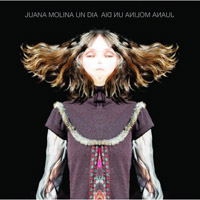
JUANA MOLINA
UN DIA (Domino B001EOQUDM)
This is mesmerizing, I can't remember when I last put on a CD and was enrapt from the first notes. There is a trance groove that is very reminiscent of Congolese electric thumb piano groups like Konono Numero Un (without their instrumentation). There is human voice in loops (like early Steve Reich on "Come out to show them" or "It's gonna rain"), saxes, electric guitars, organ, echoey bass drum, but so densely layered it is just a wall of sound, and that's just the start. The experimental aspect is intriguing. Molina comes from an arts background: her dad was a famous Tango singer and her mother an actress, and after growing up in Paris she returned to Argentina to become a tv comedienne, but gave it up for music. In the title song she sings: "Un día voy a cantar las canciones sin letra y cada uno podrá imaginar si hablo de amor, de desilusión, banalidades o sobre Platón. (One day I will sing the songs with no lyrics and everyone can imagine for themselves if it's about love, disappointment, banalities or about Plato.)" I was trying to think back to art rock bands of my youth like Young Marble Giants, but 30 years ago is so distant I can barely remember what they sounded like. However Lauri Anderson is definitely a touchstone for the sound. Molina's keyboard playing goes from funky clavinet to metallophone sounds. Her vocals and acoustic guitar are sharp and keep it all together over the hypnotic layered rhythms. One drawback is the sound overwhelms the voice so it ends up giving you the impression of needing more vocal grounding. This is the limitation of sampling with loops: it's easy to add more but hard to subtract or know when there's too much. Nevertheless this is definitely a keeper.
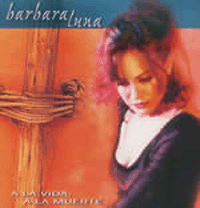
BARBARA LUNA
A LA VIDA, A LA MUERTE (Celluloid)
My musical partner-in-crime, Deejay IJ is much more adventurous than I am, so he finds stuff I would pass over, and he turns me on to some gems. He loaned me A LA VIDA, A LA MUERTE by Barbara Luna, a singer originally from Argentina. According to her website she is a world-class parachutist, as well as accomplished musician. I know nothing about tango, but there is a current of salsa in this album that is familiar and the tango orchestration of piano and bandoneon is very moody in what I'd call (in my ignorance) a Parisian way. But salsa is the chief currency in world music right now and it is done with style by artists from Senegal to Japan. The title cut starts off like a tango and then breaks into a jamming descarga. The songs are brief and polished. It reminds me of café music: little stories put across with emotion and accomplished musicianship. Apparently Ms Luna is a protégé of Yuri Buenaventura, and like the Colombian expatriate, also lives in Paris.
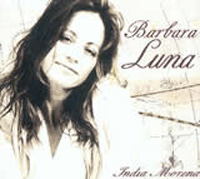
BARBARA LUNA
INDIA MORENA (Celluloid)
I don't have a lot of Argentine music and actually Barbara Luna's music reminds me more of Susana Baca than Mercedes Sosa, particularly the instrumentation of guitar, acoustic bass and percussion. But her voice is very different from Baca's. It has more of that passion we associate with protest singers of the 70s and less wispy wistful clubbiness to it. Luna has worked in Europe and been a success at WOMAD festivals and her band is well-rehearsed in various types of Latin music, from tango to salsa. The songs go from naked acapella with only the busy Hector Gomez accompanying her strong vocals on an array of percussive instruments like bombo leguero or vibraslap(!), to a fuller sound with strings, flute, keyboard and bandoneon setting the stage for her theatrical delivery. The album is well-crafted and a rewarding and passionate journey into familiar musical terrain. Samples are available on her website. See above.
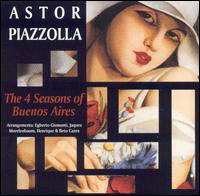
ASTOR PIAZZOLLA
THE FOUR SEASONS OF BUENOS AIRES (Edicion Piazzolla M2-36057 2004)
Since his death, Astor Piazzolla's popularity has continued to grow. Back in his prime he was lauded and even sampled by other artists: Grace Jones' hit "Rainy Nights on Hoffman Boulevard" was a straight swipe of his "Libertango" music. Though best-known for his virtuoso performance on the small accordeon known as the bandoneon, Piazzolla was also a gifted composer, as this album demonstrates. Several of his best-loved compositions have been arranged for small classical groups and the result is wonderful without falling into the trap of sounding like "light orchestral music" that turns so many film scores into margerine or shampoo commercials. The ten selections have been arranged by different arrangers (Egberto Gismonti, Jacques Morelenbaum and others), starting with the Four Seasons, performed by the Rio Cello Trio, backed by the Villa-Lobos Quintet, who play flute, clarinet, french horn, oboe and bassoon, and are accompanied by a double bassist. Interestingly, an accordeon doesn't appear until the sixth track, "Years of Solitude," where we are immediately reminded of the wistful quality of Piazzolla's melodies. A large string ensemble appears next for the Libertango suite: four mandolins, two cavaquinhos, two violes-caipiras (whatever they are: sounds like a blue alcoholic drink), two guitars, a seven-stringed guitar, double bass and percussion, in addition to accordion. Recorded in 1991, the album has been reissued in 2004 by Milan Entertainment. The same label has repackaged a Greatest Hits album, Live at the Montreux Jazz Festival and a few other gems.